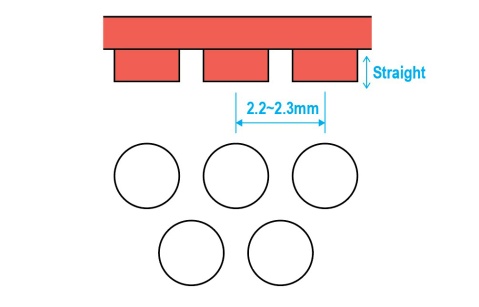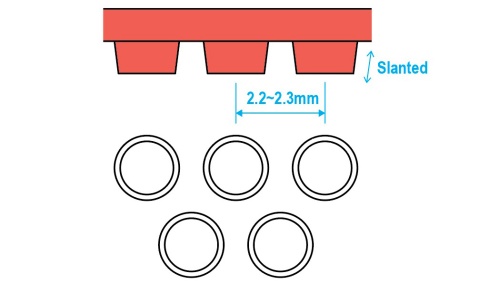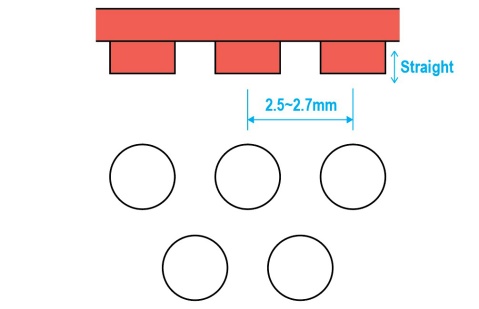After the launching of Butterfly Tenergy 05 in September 2008, the ‘New Generation’ tension rubber, i.e. Tenergy type tension rubber has become the mainstream of table tennis rubber technology. The ‘New Generation’ tensions rubber after September 2008 are clearly distinguished from the ‘Old Generation’ tension rubbers before September 2008.

As is mentioned above, the first model of ‘New Generation’ tension rubber is Butterfly Tenergy 05. In fact Butterfly Tenergy 25 was launched at the same time with Tenergy 05. But, differently from Tenergy 05, Tenergy 25 hasn’t be so successful due to the heavy weight and too unique characteristics. 7 months after the launching of Tenergy 05, Tenergy 64 which is a New Generation tension rubber with different concept was announced. Also at the end of 2009, ‘Made in Germany’ rubbers with similar technology as Tenergy 05 were launched in the market. During 5 years from 2009, most of German rubbers have changed to New Generation, i.e. Tenergy type. In 2014, finally Stiga announced Airoc series which is also New Generation tension rubber but not made in Germany. Now in 2017, most of top models in the market are New Generation tension rubbers = Tenergy type tension rubbers. Old Generation tension rubbers are still in the market, but none of those rubbers is considered as top class rubber.
The characteristics of “New Generation” tension rubbers (= Tenergy type tension rubbers) are as follows:
- The ratio of natural rubber in top sheet is very high (75~100%)
- The ratio of natural rubber in sponge is also very high (about 75%)
- The pore of sponge is visibly big
- Integrated tension effect is not permanent
On the other hand, the characteristics of “Old generation” tension rubbers are as follows:
- The ratio of natural rubber in top sheet is about 50% to make lattice structure of rubber molecule.
- The ratio of natural rubber in sponge is also about 50%.
- The pore of sponge is generally invisible.
- Integrated tension effect is permanent
As you may notice from above explanation, from the viewpoint of technology we can hardly say that New Generation tension rubber is more advanced than Old Generation tension rubber. Newer doesn’t mean more advanced. However, without doubt New Generaion tension rubber is the mainstream rubber technology now. And, more and more New Generation tension rubbers are being launched every year.
After we classify the tension rubbers into ‘New Generation’ tension rubbers and ‘Old Generation’ tension rubbers, ‘New Generation’ tension rubbers are further categorized into some types by pimple geometry. Originally that is because Butterfly announced some different models with various pimple geometries when Tenergy series is launched. The first model – Tenergy 05 – has pimple geometry with dense arrangement of pimples. The second model – Tenergy 25 which was launched at the same time with Tenergy 25 – has very wide pimples. The third model – Tenergy 64 which was launched 7 months after the launch of Tenergy 05 – has pimple geometry with sparse arrangement of pimples. And, at the end of 2009, Tibhar announced Genius whose pimple geometry looks similar to that of Tenergy 05 but in fact different. Afterward Butterfly also announced Tenergy 80 whose pimple geometry is similar to that of Tibhar Genius.
Among the various pimple geometries of New Generation tension rubbers, two kinds of ‘high density’ type and one kind of ‘low density’ type are typical, and many models are being launched every year. Although table tennis makers don’t give us detailed explanation, we can distinguish the pimple geometry by careful observation. The pimple geometry is concerned with the fundamental characteristics of rubber. However, of course pimple geometry is not all those tell the characteristics of a rubber. There are other factors, such as rubber composition or size of sponge pore, those affects the characteristics of a rubber. However, the knowledge on the pimple geometry will at least help our understanding of the fundamental concept of a rubber.
The three typical types of pimple geometry are as follows :
- Type A : High density arrangement + Cylinder shape
- Type A’ : High density arrangement + Truncated cone shape
- Type B : Low density arrangement + Cylinder shape
Please note that Type A, Type A’ and Type B are not common names of pimple geometries. Those names are used just on this blog for each classification.
Each type has its own fundamental characteristics.
Type A : High density + Cylinder shape = Tenergy 05 type

This ‘Tenergy 05 type’ is the first geometry of New Generation Tension rubber. And, most of current top models of various table tennis companies are with this geometry. ‘High density’ means that the distance between center of pimple and center of pimple is about 2.2~2.3mm. (Please note that ‘rubber’ is not a stiff material, and for that reason it can be elongated or reduced a bit by various reasons.) This is quite dense arrangement of pimples, and for that reason the top sheet of this type is relatively heavier than those of other types. The shape of pimple is cylinder. I.e. the side of pimple is perpendicular to sheet surface. The length of pimple is about 0.8~0.9mm.
Originally, this geometry is for maximum spin capability. Although it makes relatively harder feeling due to dense arrangement of pimples, the vertical rebound speed is not high. It is very easy for players to make strong spin. The ball draws high arc very easily. At the time when Tenergy 05 was launched, Butterfly explained that Tenergy 05 is an all-round rubber with very good spin capability. It is not for hard hitters but for the players who lay most emphasis on spin. Also the first German rubbers with this geometry those were launched at the end of 2009 provides good spin capability with relatively harder feeling like Tenergy 05.
However, currently the rubbers with this pimple geometry (High density + Cylinder shape) are not restricted to the rubbers for spin. We can very fast rubbers with this pimple geometry. Table tennis makers try to make more variation of performance while keeping this pimple geometry, by adjusting the composition of rubbers and other factors. Of course, there are also the rubbers with very typical characteristics of this pimple geometry. And, even though the speed of a rubber with this pimple geometry is high, it doesn’t mean that the spin capability of that rubber is lower than that of another rubber with same composition and different pimple geometry. If the composition is identical and the sponge is same, this pimple geometry always provides the highest capability of spin.
The shortcoming of this pimple geometry is relatively heavier weight. Some players may say that the relatively harder feeling is also the shortcoming of this geometry.
Type A’ : High density + Truncated Cone shape = Softened Tenergy 05 type

This type is usually introduced as the intermediate version between Type A (Tenergy 05 type) and Type B (Tenergy 64 type). With bare eyes it is very difficult for us to distinguish this type from original Tenergy 05 type. For that reason this type is usually dealt as a kind of Tenergy 05 type. That is the reason why I call it as Type A’ instead of Type C. This type is also the pimple geometry with ‘high density’ arrangement of pimples. As type A (= original Tenergy 05 type), the distance between center of pimple and center of pimple is about 2.2~2.3mm. But, the pimple shape of this type is ‘truncated cone’ whose side is not perpendicular to sheet surface but a bit slanted, while the pimple shape of original Tenergy 05 type is ‘cylinder’. The length of pimple is the same as that of original Tenergy 05 type. Thanks to the shape of pimple, the pimples can eat into sponge more easily. As a result, Type A’ is softer than Type A. And, because the vertical elasticity of sponge can be used more efficiently, Type A’ provides higher speed than Type A, if all the other factors are identical.
This type was made for the halfway characteristic between Type A (= Tenergy 05 type) and Type B (= Tenergy 64 type). Originally Type A is for spin, and Type B is for speed. Also, originally Type A is relatively hard due to dense arrangement of pimples, and Type B is relatively soft due to sparse arrangement of pimples. So Type A’ is faster than Type A, and provides more spin than Type B. Also, Type A’ is softer than Type A, but harder than Type B. The typical case is Butterfly Tenergy 80 which is between Tenergy 05 and Tenergy 64 according to Butterfly. However, Tenergy 80 is not the first rubber of this type. The first model of Type A’ is Tibhar Genius which was launched at the end of 2009 that is three years before the launching of Tenergy 80.
Currently, most of rubbers with this pimple geometry provide ‘quite good spin although not extreme’, ‘quite high speed although not highest’ and ‘moderate feeling that is not too hard and not too soft’. The most important meaning of this type is that it feels the gap between Type A (= Tenergy 05 type) and Type B (= Tenergy 64 type). We may be able to say that Type A’ is more balanced than two other extreme types – Type A for spin and Type B for speed.
But, of course there are exceptions. Some rubbers of this type are very close to original Tenergy 05 type (= Type A), or provide even more extreme spin performance. You will not be able to notice that the pimple geometry of those rubbers is this type if you just test those rubbers at you club. In some cases it is doubtful whether distinguishing between Type A and Type A’ is meaningful or not. Please note that this knowledge doesn’t tell everything. By the adjustment of other factors of rubber, makes can make different characteristics of rubber. So please don’t expect the characteristics of a rubber by just examining its pimple geometry.
Type B : Low density + Cylinder shape = Tenergy 64 type

The first product with this pimple geometry is Butterfly Tenergy 64 which was introduced in spring 2009. This pimple geometry is noticeably different from Type A or Type A’. Basically the shape of pimple is the same as that of Type A. However, the pimples of Type B are sparsely arranged while the pimples of Type A or Type A’ are densely arranged. So it can be called as ‘low density’ type. The distance between center of pimple and center of pimple is about 2.5~2.7mm.
This pimple geometry is for high speed. And, the sparse arrangement makes feeling relatively soft. So ‘soft feeling and high speed’ is the characteristics of pimple geometry ‘Type B’ (= Tenergy 64 type). Butterfly is also explaining that Tenergy 64 is faster than Tenergy 05 but the spin capability of Tenergy 64 is lower than that of Tenergy 05. The ball trajectory made by type B is lower than that made by Type A because type B creates less spin. But, thanks for its soft feeling, it is very comfortable for player to hit ball directly.
Differently from Type A and Type A’, there aren’t many models whose pimple geometry is Type B. Most of table tennis companies are concentrating on Type A or Type A’. As a result, relatively fewer models with Type B geometry have been launched in the market for these some years. Further, some table tennis makers even deal with the models with Type B geometry as entry level rubbers just because of soft feeling, relatively high speed and relatively low trajectory.
Although some top players are using Tenergy 64, the spin capability of Type B geometry will not be sufficient for most of top players. Instead, the rubber with Type B geometry can be recommended for entry players because of softer feeling and higher speed. It will be difficult for entry players to fully utilize the ability of Type A. But, Type B is very easy to use for entry players.
One reason why there aren’t many models with Type B geometry is that table tennis makers can make the rubbers with Type A or Type A’ geometry those are similar to the rubbers with Type B geometry. Of course the rubbers with Type A or Type A’ geometry can’t be 100% same as the rubbers with Type B geometry. But, at least the rubbers with Type A or Type A’ can be softer or faster than we may expect. Type A and Type A’ can be used for wide variation of performance characteristics. On the contrary, the characteristics of Type B is limited to ‘softer feeling and higher speed’.
Solid advantage of Type B is lighter weight thanks to sparse arrangement of pimples. Of course this advantage may be diluted by heavier rubber composition of top sheet or higher density of sponge. But, if all other factors are identical, Type B is always lighter than Type A and Type A’.
Summary
- There are some kinds of pimple geometries in New Generation tension rubbers.
- Three typical types are (A) High density + Cylinder shape, (A’) High density + Truncated Cone shape and (B) Low density + Cylinder shape.
- Type A (High density + Cylinder shape) is originally for SPIN. Originally this type isn’t for high speed. Instead, the advantage of this type is high spin capability and very high trajectory of topspin. However, nowadays there are many rubbers of this type those provide very high speed.
- Type A’ (High density + Truncated cone shape) is the halfway between Type A and Type B. It is faster than Type A and provides more spin capability than Type B. But, of course there are exceptions.
- Type B (Low density) is for SPEED and SOFTNESS. Spin capability of this type is lower than that of Type A or Type A’. But, Type B can make faster ball. The trajectory of topspin is relatively low. Thanks to soft feeling, this type fits for entry players.
- Among three typical types of New Generation tension rubbers, Type A and Type A’ are usually considered as the rubbers for top players. On the contrary, Type B are dealt as entry models by some table tennis companies.
Unauthorized use and/or duplication of this material without express and written permission from this blog’s author and/or owner is strictly prohibited. Excerpts and links may be used, provided that full and clear credit is given to TTGear Lab with appropriate and specific direction to the original content.

What great post! I really appreciate it…
LikeLike
Thank you for comment!
LikeLike
I like this post!!!!
LikeLike
Thank you a lot!
LikeLike
Super great and interesting post! Do you know the pimple geometrie of Xiom Vega Pro and Tibhar Evolution MX-P? Also Typ A, A’ or B? I was always wondering about that because I was never completely satisfied with them like with Tenergy 05.. so I was wondering maybe it’s because their Typ A’ or B and not A like Tenergy 05?!
LikeLike
Thank you for comment. Both of those are Typ A. However the shape and arrangement of pimples doesn’t tell everything of a rubber. Both of those are quite different from Tenergy 05 although they share the pimple geometry. We have to use the knowledge on pimple geometry only for reference.
If you like the feeling and ease of use of Tenergy 05, Evolution EL-S may be much better than Evolution MX-P. Evolution EL-S is equipped with softer sponge, and therefore it gives less speed and less spin. However, you may like it’s feeling.
If you need power, Aurus Prime or older Genius may be more satisfactory for you. Please try those two models if you have a chance.
LikeLike
Greate post. It’s really useful
LikeLike
Very useful article.Thank you! What do you think are the best alternatives to Tenergy 05? I use Aurus Prime, but I think top spin is made harder compared to Tenergy 05.Do you have experience with new rubber Tibhar MX-K and MX-K H, I saw a very good opinions of them? Unfortunately these rubbers are only available in Korea, do you have any idea why?
LikeLike
Thank you for comment. I heard that MX-K is quite close to Tenergy 05, but I’m not sure because I haven’t tried it yet. I hope that I have a chance.
However, you may feel that it is also different from Tenergy 05. Especially the feeling of top sheet differs by person. I feel that the top sheet of Aurus Prime is softer than that of Tenergy 05. (Just the opposite of your feeling. I hope that the the top sheet of Aurus Prime is somewhat harder than current one.) You may feel that the top sheet of MX-K is even harder.
I think that Stiga DNA PRO M can be good replacement of Tenergy 05 for topspin players. However, its top sheet is also very hard. For that reason I don’t recommend DNA PRO M for you.
LikeLiked by 1 person
Thank you for the reply.I think to try Evolution EL-S and Xiom Omega VII Euro .I guess it will be interesting for everyone what are your favourite rubbers.
LikeLike